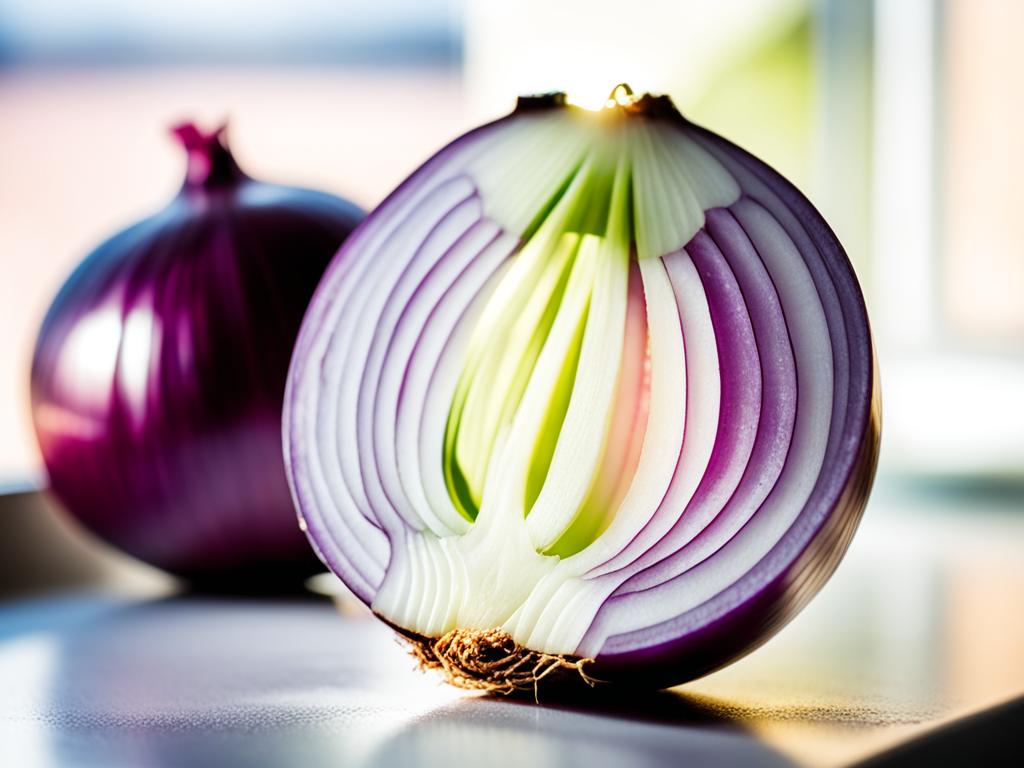Learn how to grow onions from onions with this easy DIY guide. I’m excited to share simple techniques for growing your own flavorful onions at home. This guide is perfect for both seasoned gardeners and beginners. It covers everything from materials needed to harvesting your onions.
You’ll learn how to regrow onions from onion bottoms. We’ll go through preparing the onion cutting, potting, and transplanting. You’ll also get tips on how to care for your onions and harvest them. Get ready to enjoy the joy of growing your own onions from scratch!
Getting Started with Onion Propagation
Growing onions from scraps is a fun and rewarding way to have fresh produce at home. You’ll need a few basic items to start this easy project. The main thing is to use the onion bottom, which has the roots needed for new growth.
Materials Needed
- An onion (any variety will work, but green onions tend to regrow more quickly)
- A sharp, clean knife
- A cutting board
- A starter pot or container with well-draining potting soil (optional)
Start by cutting off the onion bottom, leaving 1.5-2 inches of the “meat” and roots. This part will grow into your new onion plant. Then, let the onion bottom dry and form a callous in a shaded, well-ventilated spot for a few hours to a couple of days.
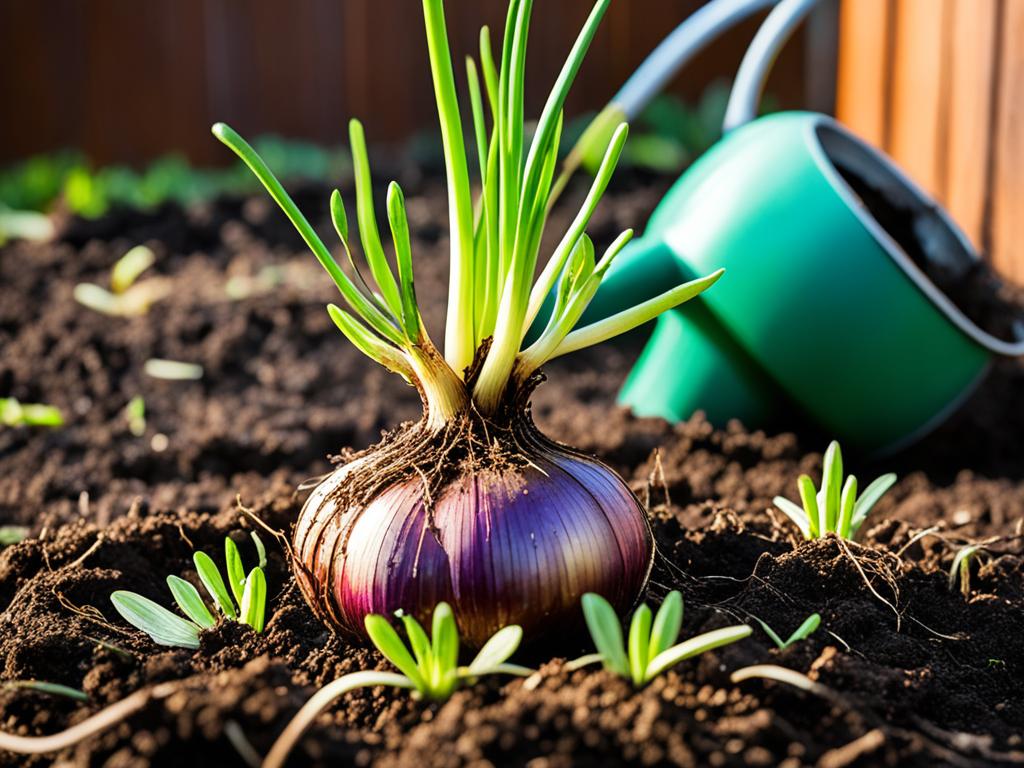
With your materials ready, you’re ready to grow onions from onions! Next, we’ll look at how to prepare the onion cutting for planting.
Preparing the Onion Bottom
First, get your onion bottom ready for planting. Use a sharp knife to slice off the top, leaving 1.5-2 inches of roots. This is key for how to prepare onion bottom for planting.
Then, lay the onion bottom flat on a dry spot, with the cut side up. Let it dry for 12-24 hours until it’s calloused and dry. This drying, or onion cutting callousing process, stops rot and helps new roots grow.
Slicing and Drying
Here’s how to slice and dry onions for propagation:
- Use a sharp, clean knife to slice off the onion bottom, leaving 1.5-2 inches of the root system attached.
- Arrange the onion slices on a flat, dry surface, such as a baking sheet or paper towel, with the cut side facing up.
- Allow the onion cuttings to dry for 12-24 hours, or until they are calloused and dry to the touch.
- During this drying process, the onion cutting will begin to form a protective layer, which is essential for successful regrowth.
By following these simple steps, you’ll have your onion bottoms prepped and ready for the next stage of propagation.
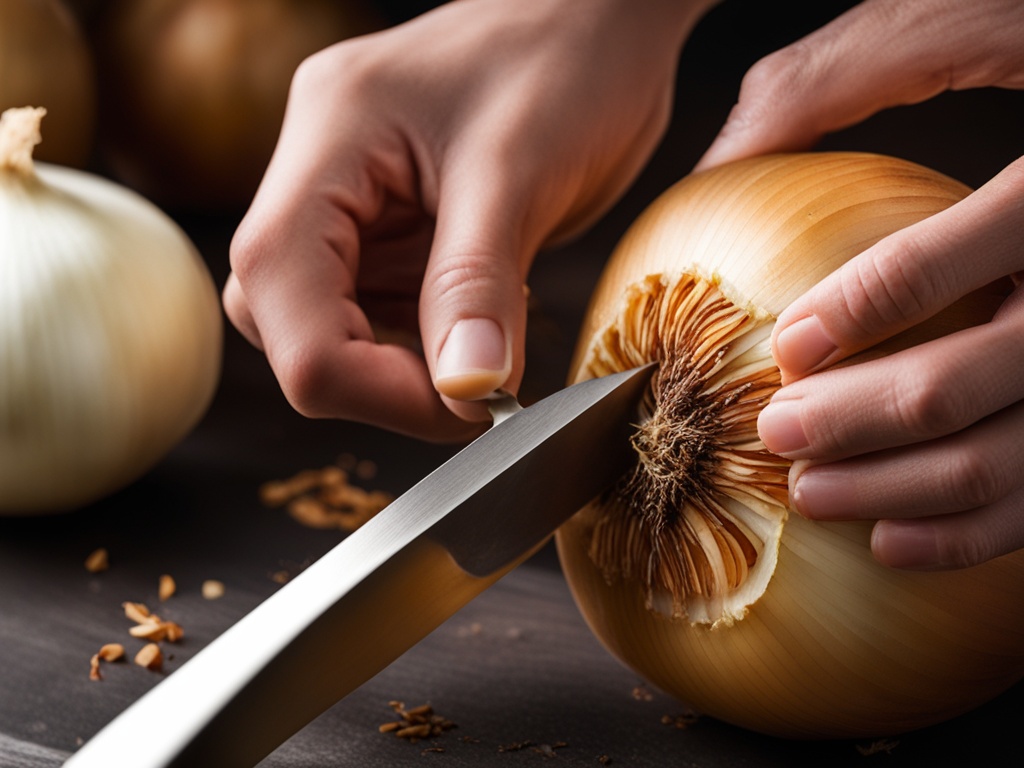
Potting the Onion Cutting
Now it’s time to pot your onion cutting! This step is key to growing onions from onions. Make sure your onion bottom is dry after slicing. Then, pick the best spot to plant it.
You can plant your onion cutting in the ground or in a pot with good soil. For a pot, fill it with soil, leaving room for the onion. Put the onion bottom in a hole, cover it with more soil, and water it well.
When planting onion bottoms in pots, choose a container with good drainage. This stops the roots from getting too wet. Growing onions in containers is great if you don’t have much garden space.
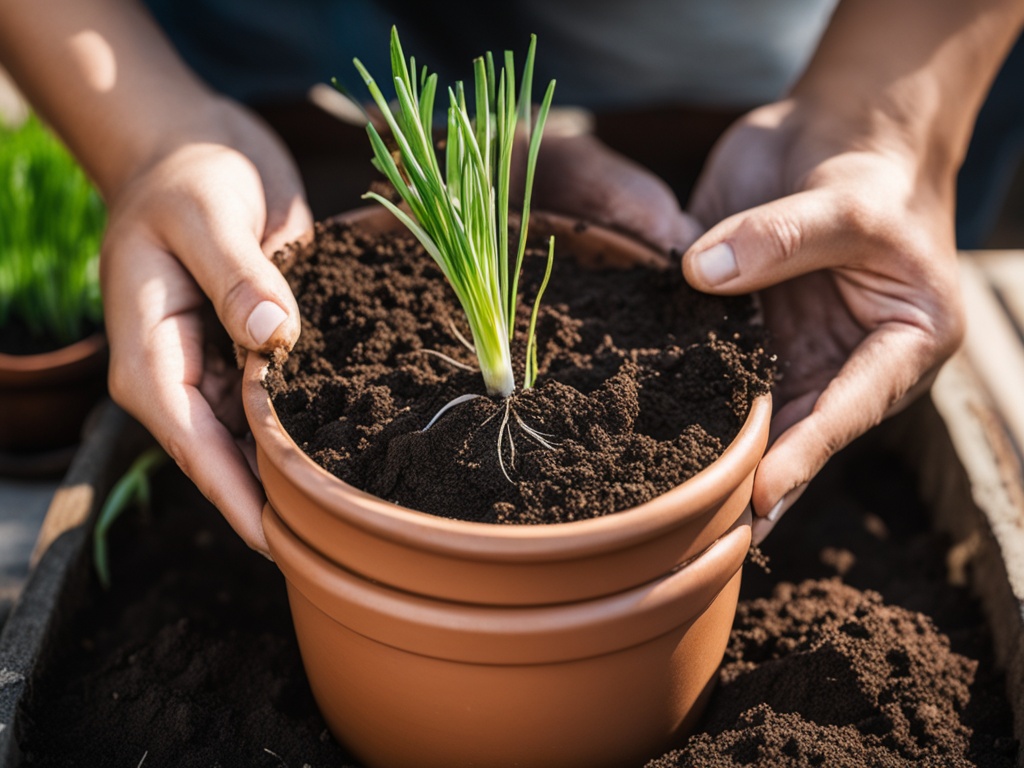
You can also plant your onion cutting directly in the ground. Just pick a spot with good drainage and bury the onion. It’s simple! Your onion cutting is now on its way to becoming a full onion plant.
Success comes from giving your onions the right conditions. Watch over your potted onion cuttings or in-ground onion bottoms. Adjust as needed to help them grow well.
Transplanting and Regrowing
When your onion cutting grows a few leaves, it’s time to move it to a garden bed or a bigger pot. Carefully separate any new plants that have grown from the onion bottom, making sure each has roots. Cut the leaves back to about one-third of their size before transplanting. This helps the plant grow stronger and form a bulb.
You can keep doing this to get more onions. Vanessa Greaves, for example, hasn’t bought green onions in two years, only for demos. This method makes it easy to have fresh onions at home.
- Transplant onion cuttings with attached roots to a prepared garden bed or larger container
- Cut leaves down to one-third of their original size to reduce stress on the plant
- Repeat the process as needed, harvesting onions when they form flowers
- Regrow onions from scraps to enjoy a never-ending supply of fresh produce
Moving onion plants to the garden is easy and lets you keep onions growing from kitchen scraps. With a bit of care, you can pick your own onions whenever you want.
“By regrowing green onions from kitchen scraps, individuals can obtain an almost endless supply of fresh green onions.”
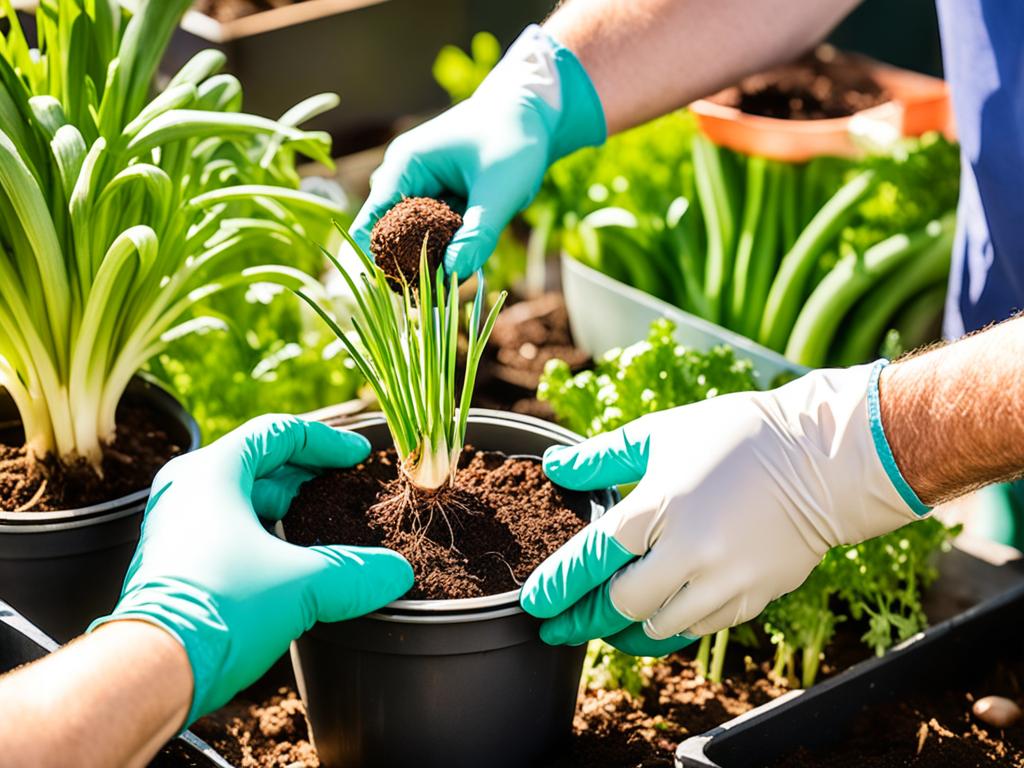
Keep the roots of your onions in water and change the water weekly. Once they’re about four to five inches tall, move them into the ground or a pot with good soil. Not moving them can weaken the onions and stop them from producing.
To harvest, cut the leaves right down to the ground. The onions will keep growing from the cut ends, giving you a steady supply. In some places, these onions might even come back in the spring.
How to Grow Onions from Onions
Essential Steps
Onions are easy to regrow from their scraps. With a few simple steps, you can grow a new crop of onions from kitchen scraps. Here are the key steps to follow.
- Cut the onion bottom, leaving 1.5-2 inches of the root system attached. This root portion is crucial for growing a new onion plant.
- Let the onion cutting dry and callous for 12-24 hours. This step prevents rot and helps new roots grow.
- Plant the onion bottom in a starter pot or directly in the ground, covering it with soil. Make sure to water the soil well.
- Feed the onion cutting with a nitrogen-rich fertilizer to help it grow strong foliage and roots.
- When the onion plant gets bigger, move it to a larger container or garden bed. This lets it spread out.
- Pick the onions when the plant starts to flower, usually 90-120 days after planting the cutting.
By following these steps, you can grow onions from onions. This is a sustainable and cost-effective way to have this kitchen staple at home.
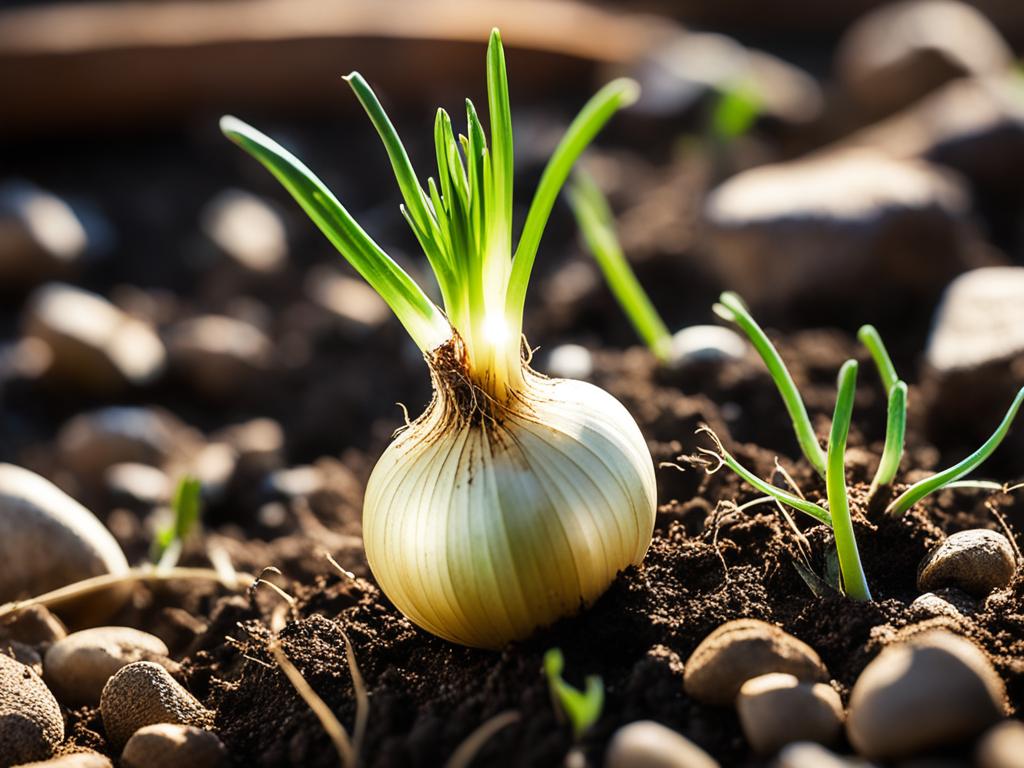
Onions are a key ingredient in many cuisines around the world. Growing them from scraps lets you have a variety of bulbs for different dishes. With patience and the right methods, you can enjoy a harvest of homegrown onions from your kitchen.
Caring for Your Onion Cutting
Taking good care of your onion cutting is key to its growth and success. With the right care, you can enjoy a great harvest of onions from your garden. Here are the main steps to follow for your onion cutting.
Watering Your Onion Plants
Onions need steady moisture to grow well. Water your onion cutting about 1 inch per week. Keep the soil moist but avoid overwatering. If you don’t water evenly, you might get bulbs that split or growth that stops.
Fertilizing for Healthy Onions
Feed your onion cutting with a nitrogen-rich fertilizer every 2 weeks before the bulb forms. This helps with strong foliage and bulb growth. Always use the fertilizer as the package says.
Maintaining Weed-Free Soil
Weeds can take nutrients and water from your onions. Remove any weeds that come up to help your onions grow better.
Monitoring for Pests and Diseases
Watch for pests or diseases that could harm your onions. Deal with problems like thrips, onion maggots, or fungi quickly to protect your crop.
By taking these steps, you’ll help your onion cutting grow well. With the right care, you’ll soon be enjoying your own onions from home!
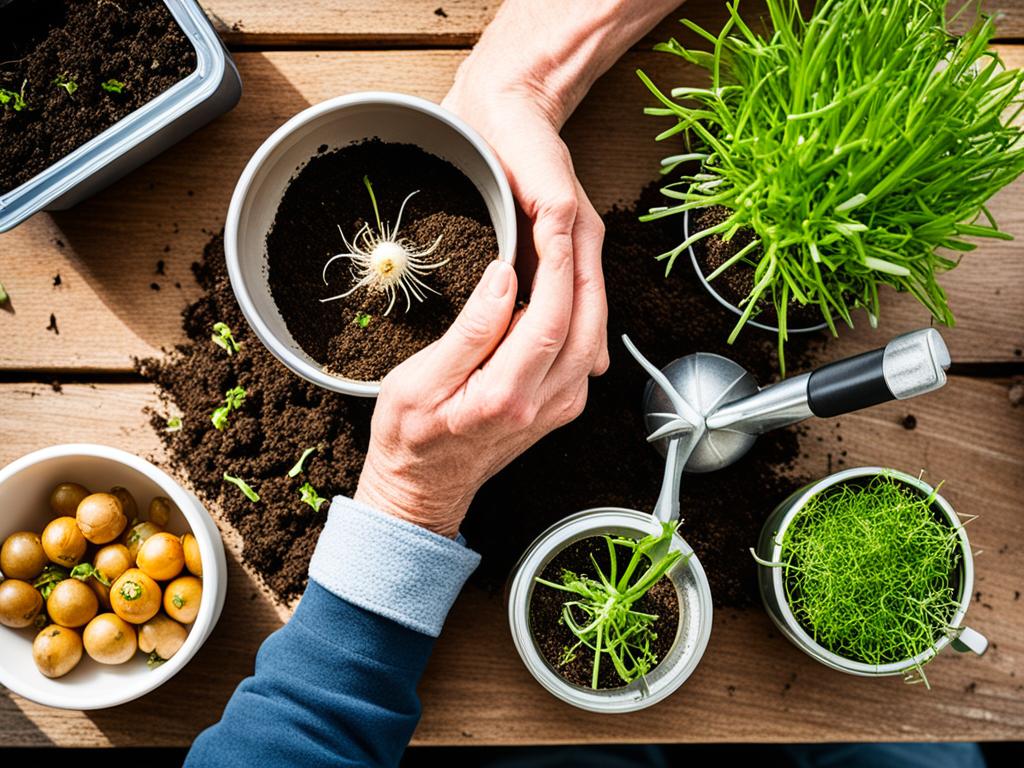
| Care Aspect | Recommended Approach |
|---|---|
| Watering | Provide 1 inch of water per week, keeping soil moist but not waterlogged |
| Fertilizing | Apply nitrogen-rich fertilizer every 2 weeks until bulb emergence |
| Weed Control | Regularly remove weeds to prevent competition for nutrients and water |
| Pest and Disease Monitoring | Closely inspect for issues like thrips, onion maggots, and fungal diseases |
Harvesting Your Homegrown Onions
Harvesting your homegrown onions is a big step in gardening. It’s important to know when to pick them for the best taste and yield. Wait until the plant starts flowering and the leaves turn yellow and dry.
Use a small shovel or fork to carefully loosen the soil around the onion plant. Then, pull the onion out by its leaves, being careful not to harm the bulb. Onions from cuttings usually take 90-120 days to grow a full bulb.
After picking, let your onions dry in a warm, airy spot, away from direct sunlight, for 2-4 weeks. This drying, or curing, process makes the onion’s skin dry and protective. It also helps keep the onions fresh for longer. Once dried, store them in a cool, dark place for up to 8 months.
| Onion Harvesting Tips | Ideal Conditions |
|---|---|
| Harvest when 2/3 of the foliage has fallen over | 80% foliage die-back for optimal flavor |
| Cure onions for 2-4 weeks at 75-90°F | Store at 32-36°F to prevent sprouting |
| Leave green tops on during curing | Humidity levels between 65-75% |
By using these harvesting onions grown from scraps and curing them right, you can enjoy your onions for months. Good onion harvesting tips help keep your homegrown onions fresh and tasty.
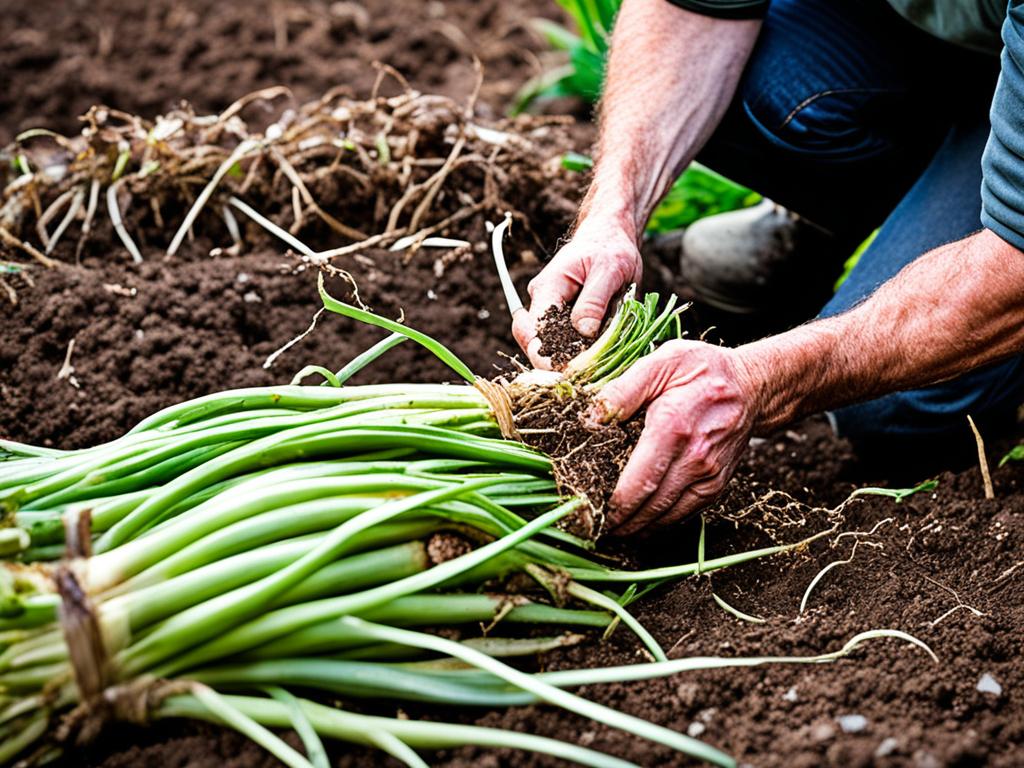
“Curing onions is crucial for better storage. Poorly cured onions are more prone to storage rots.”
Onion Growing Tips and Tricks
Expert Advice
Growing onions can be rewarding but has its challenges. We’ve gathered advice from experts Steve Masley and Pat Browne of Grow it Organically. They share onion growing tips and tricks for successful onion cultivation.
Experts say leaving the green onion shoots in place helps onions grow bigger. Each leaf adds a layer to the bulb. They also warn against using weed killers near onions, as they can harm the plants.
Choosing the right onion variety is key, the experts say. Short-day onions do well in the south, while long-day onions are better in the north. Picking the right type for your area can greatly improve your harvest.
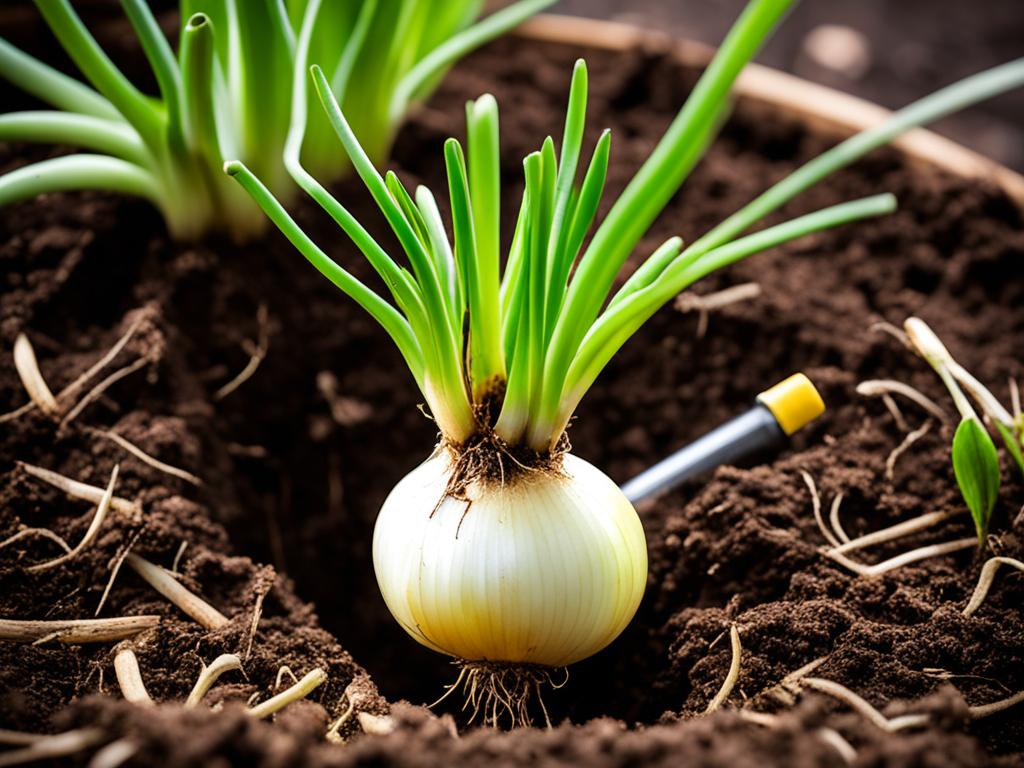
Onions need consistent moisture and nutrients, the experts stress. They are heavy feeders and need balanced fertilizer at transplanting and nitrogen-rich solutions later. This helps them grow well.
By using these onion growing tips and tricks, you can have a great onion harvest. With the right methods and patience, you’ll enjoy your homegrown onions and impress others.
Starting Onions in Pots or Garden Beds
Growing onions can be done in pots or directly in your garden. The choice depends on how much space you have and what you prefer. Both methods need the right conditions for onions to grow well.
Planting Onions in Containers
If you’re short on space or want control over your onions, containers are a great choice. Pick a potting mix that drains well and a container with good drainage holes. Onions do best in soil with a pH of 6.0 to 7.0, so adjust your mix if needed.
Growing Onions in Garden Beds
For those with garden beds, planting onions directly in the ground is fulfilling. Make sure the soil drains well and has nutrients by adding compost or fertilizer before planting. Plant onion sets or seeds in mid to late March, so they get established before it gets hot.
Whether you grow onions in containers or garden beds, they need the same care. Keep the soil moist but not too wet. Onions love full sun, so give them plenty of sunlight. With proper care, you’ll enjoy a big harvest of onions.
| Planting Method | Timing | Soil Requirements | Spacing |
|---|---|---|---|
| Onions in Containers | Mid to late March | Well-draining potting mix, acidic pH 6.0-7.0 | 4-6 inches apart |
| Onions in Garden Beds | Mid to late March | Well-draining, nutrient-rich soil | 4-6 inches apart |
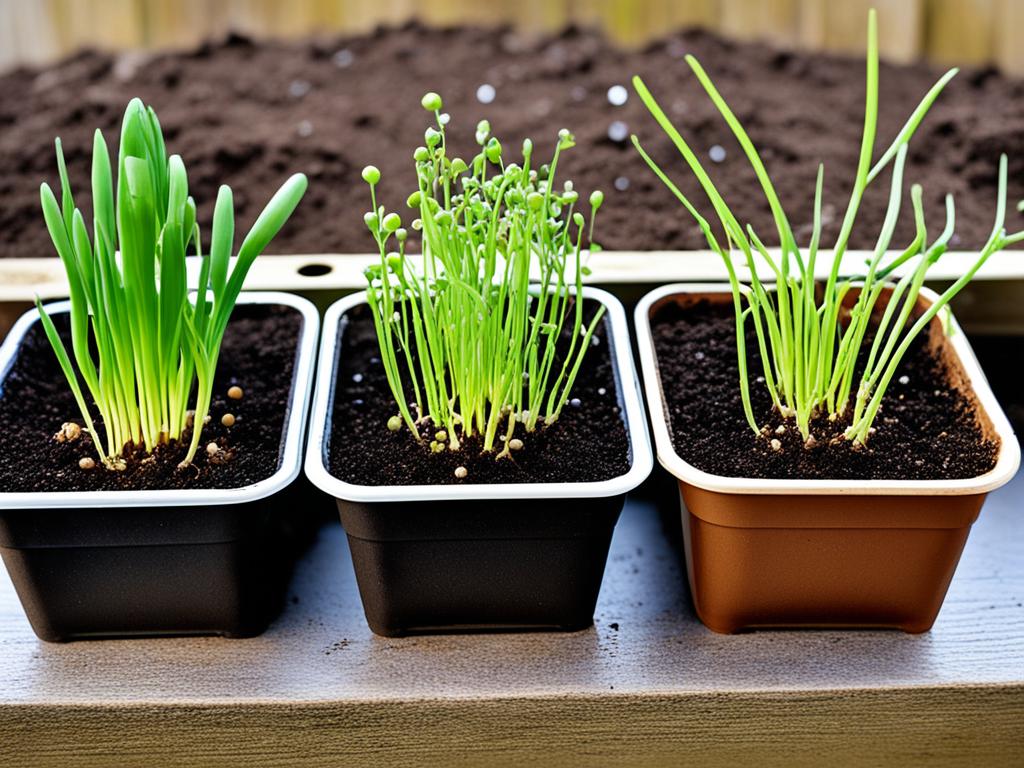
Choosing to grow onions in containers or onions in garden beds is up to you. The secret to success is giving them the right conditions and taking good care of them. With some effort, you’ll get a big harvest of onions from your own garden.
Trouble-Shooting Common Issues
Growing onions can be rewarding, but it has its challenges. If your onions look limp, discolored, or unhealthy, you might have a common issue. Let’s look at some common onion growing problems and how to fix them.
Identifying and Addressing Onion Plant Diseases
Onions can get sick with diseases like pink root, downy mildew, and botrytis rot. If you see these problems, act fast. Move the sick plant away from others and get advice from a nursery or expert. Quick action and the right treatment can stop disease from spreading and keep your onions healthy.
Dealing with Weeds and Pests
Weeds and pests can hurt your onion crop. Onion thrips, onion maggots, and wireworms are pests to watch out for. Onions don’t grow well with weeds, which can slow them down. Keep an eye on your garden for weeds and pests, and deal with them quickly to keep your onions healthy.
Addressing Nutrient Deficiencies
Onions need a lot of nutrients to grow well. Phosphorus or potassium deficiency can make onion bulbs grow thick at the neck. Make sure your onions get the right nutrients from good soil or a quality fertilizer.
Being careful and fixing problems fast can help you grow healthy onions. Every garden is different, so don’t be afraid to ask experts or seasoned gardeners for advice. This way, you can overcome common onion growing issues and have a great harvest.
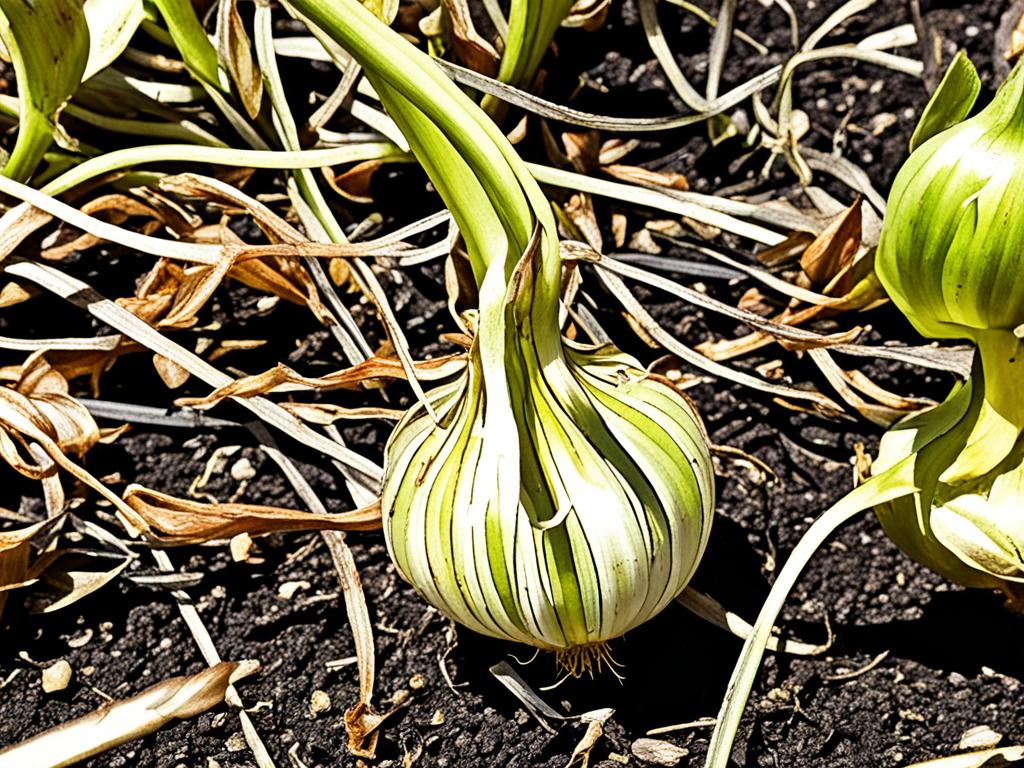
| Common Onion Growing Issues | Symptoms | Potential Causes | Solutions |
|---|---|---|---|
| Pink Root | Wilting, discoloration, and stunted growth | Soilborne fungus | Rotate crops, improve soil drainage, and use resistant varieties |
| Downy Mildew | Yellowing and moldy growth on leaves | Fungal disease that thrives in wet, humid weather | Improve air circulation, apply fungicides, and plant resistant varieties |
| Botrytis Rot | Soft, spongy bulbs with gray mold | Fungal disease that attacks onion necks and bulbs | Ensure proper curing and storage, avoid overhead watering |
| Onion Thrips | Stippling, silvering, and curling of leaves | Small insects that feed on onion foliage | Use row covers, apply insecticidal soap or neem oil |
| Onion Maggots | Tunnels and cavities in onion bulbs | Larvae of a small fly that feed on onion roots and bulbs | Practice crop rotation, use row covers, and apply insecticidal baits |
| Wireworms | Damaged roots and tunnels in onion bulbs | Larvae of click beetles that feed on underground plant parts | Improve soil drainage, use beneficial nematodes, and rotate crops |
| Nutrient Deficiencies | Thick necks, poor bulb development | Lack of essential nutrients like phosphorus or potassium | Amend soil with balanced fertilizer or compost, perform soil testing |
By solving these common onion problems, you can grow a successful onion crop. Always be alert, seek expert advice, and adjust your gardening methods for your local climate.
Seasonal Tips for Growing Onions
Onions can grow well in spring and fall, even in cold zones like 5 and 6, with winter protection. Start onion cuttings in early spring for spring planting. For fall, plant onions 4-6 weeks before the first frost. In warmer areas, onions can grow all year. Adjust your planting and care to fit your local climate and season.
Popular onion types include scallions, shallots, yellow, white, red onions, Vidalia onions, and leeks. Short-day onions work best in zones 7 and up, while long-day onions are for zones 6 and below. Day neutral onions grow in most zones.
Short-day onions form bulbs with 10-12 hours of sunlight. Day neutral onions need 12-14 hours, and long-day onions need 14-16 hours. Think about the light needs of each onion type for the best growth.
| Onion Variety | Ideal Garden Zone | Daylight Hours for Bulb Formation |
|---|---|---|
| Short-day Onions | Zones 7 and higher | 10-12 hours |
| Long-day Onions | Zones 6 and lower | 14-16 hours |
| Day Neutral Onions | Most zones | 12-14 hours |
Onions need at least 12 hours of sunlight and rich soil with compost. Mulching helps fight weeds and keep soil moist. But, be careful not to overwater to avoid rot.
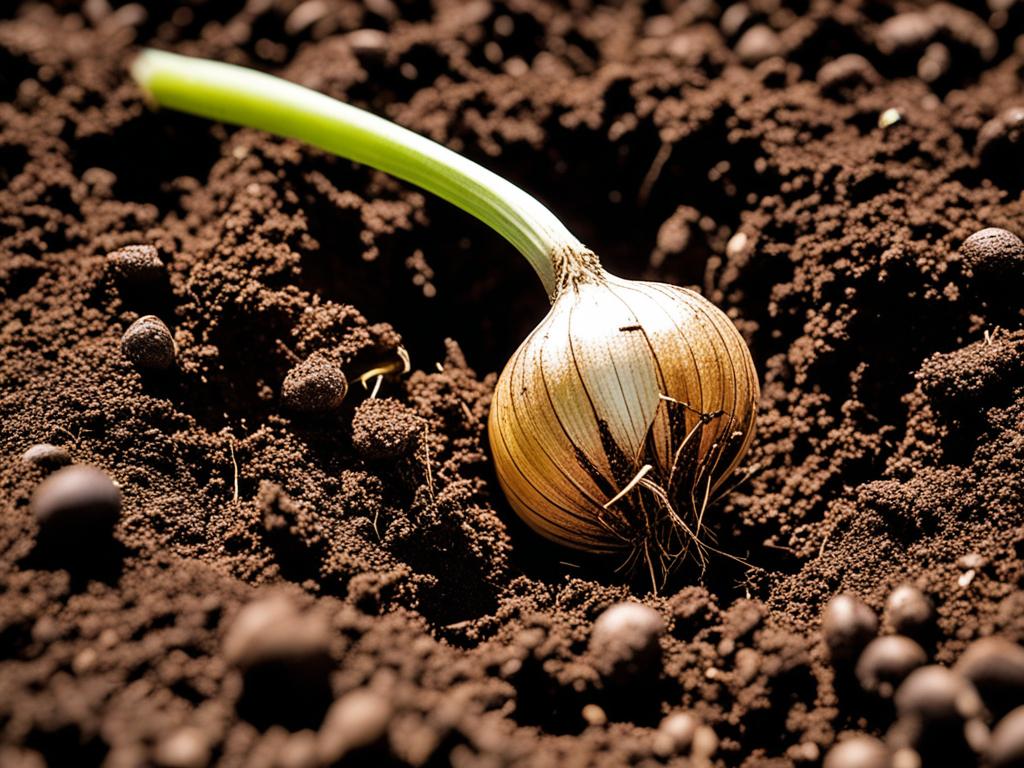
Knowing the seasonal and light needs of onions helps you grow them all year. Whether in spring, fall, or year-round, you can succeed with onions.
Conclusion
Growing onions from scraps is easy and rewarding. You can make your own flavorful onions at home. Just follow the steps in this guide to grow onions from kitchen waste. This method saves money, cuts down on food waste, and lets you enjoy growing your own food.
Starting with onion cuttings in pots or directly in the garden is simple. It’s a great way to grow onions yourself. You’ll save money and feel proud of your homegrown produce.
Getting started with onion cuttings is easy. You just need to prepare the onion bottom, transplant it, and regrow it. With some mulching, balanced fertilizing, and proper care, you’ll have healthy onions all season.
Regrowing onions has many benefits. You get to taste the fresh flavor of your own onions. It also helps the planet by reducing waste and cutting down on store-bought produce. So, why not try growing your own onions today?
FAQ
What materials do I need to get started with growing onions from onions?
You’ll need an onion, a clean knife, a cutting board, and a starter pot with potting soil (optional).
How do I prepare the onion bottom for planting?
Slice off the onion bottom, leaving 1.5-2 inches of the attached “meat” with roots. Let it dry in a shaded, well-ventilated spot for 12-24 hours to callous.
Can I plant the onion bottom directly in the ground or do I need to start it in a pot?
You can plant it directly in the ground or start it in a pot with well-draining soil. Fill the pot two-thirds with soil, make a hole, and put the onion bottom in it.
What are the key steps to growing onions from onions?
The steps are: 1) Cut the onion bottom, leaving 1.5-2 inches of roots. 2) Dry and callous the cutting for 12-24 hours. 3) Plant it in a pot or ground, covering it with soil. 4) Water and fertilize with nitrogen-rich fertilizer. 5) Move the plant to a bigger container or garden bed as it grows. 6) Harvest when the plant forms flowers, about 90-120 days after planting.
How do I care for my onion cutting as it grows?
Water it regularly, about 1 inch a week, keeping the soil moist but not too wet. Fertilize with nitrogen-rich fertilizer every 2 weeks until the bulb starts to show. Weed around the plant to prevent competition for nutrients and water.
How do I know when my onions are ready to harvest?
Check when the plant starts to form flowers. Use a shovel to loosen the soil, then pull the onion by its base. Onions take 90-120 days to grow a new bulb.
What are some expert tips for growing onions from onions?
Experts say you can harvest green onion shoots anytime. But leaving them helps onions grow bigger. Also, avoid weed killers near onions as they can harm the plants.
Can I grow onions from onions year-round or only in certain seasons?
Onions can be grown in spring and fall, even in cold zones (5 and 6) with winter protection. Start spring onions early and fall ones 4-6 weeks before frost. Warmer areas may allow year-round growth.
